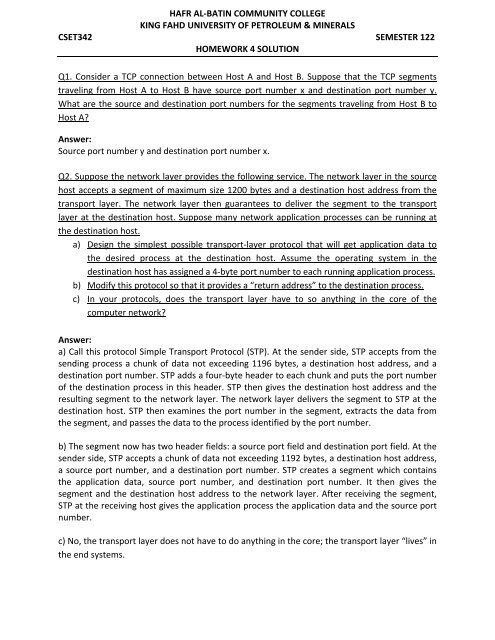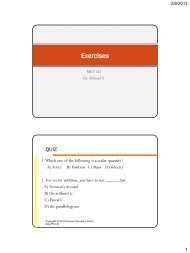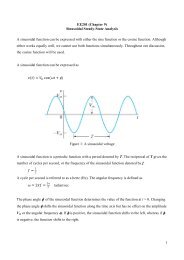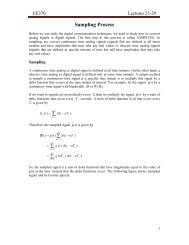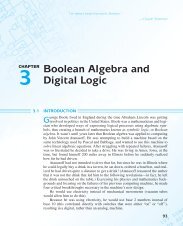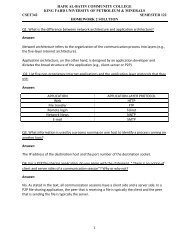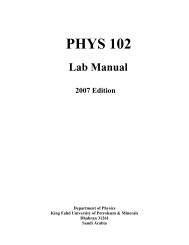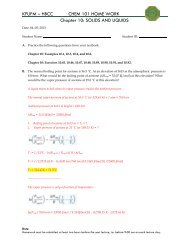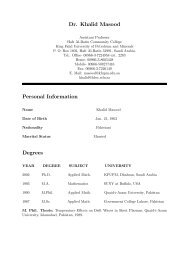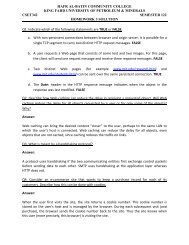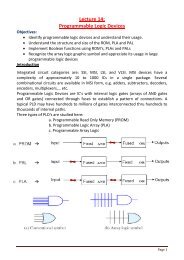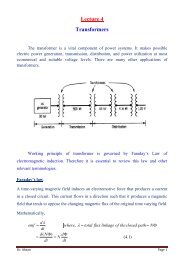Homework 4 Solution - Hafr Al-Batin Community College(HBCC)
Homework 4 Solution - Hafr Al-Batin Community College(HBCC)
Homework 4 Solution - Hafr Al-Batin Community College(HBCC)
Create successful ePaper yourself
Turn your PDF publications into a flip-book with our unique Google optimized e-Paper software.
HAFR AL‐BATIN COMMUNITY COLLEGE<br />
KING FAHD UNIVERSITY OF PETROLEUM & MINERALS<br />
CSET342 SEMESTER 122<br />
HOMEWORK 4 SOLUTION<br />
Q1. Consider a TCP connection between Host A and Host B. Suppose that the TCP segments<br />
traveling from Host A to Host B have source port number x and destination port number y.<br />
What are the source and destination port numbers for the segments traveling from Host B to<br />
Host A?<br />
Answer:<br />
Source port number y and destination port number x.<br />
Q2. Suppose the network layer provides the following service. The network layer in the source<br />
host accepts a segment of maximum size 1200 bytes and a destination host address from the<br />
transport layer. The network layer then guarantees to deliver the segment to the transport<br />
layer at the destination host. Suppose many network application processes can be running at<br />
the destination host.<br />
a) Design the simplest possible transport‐layer protocol that will get application data to<br />
the desired process at the destination host. Assume the operating system in the<br />
destination host has assigned a 4‐byte port number to each running application process.<br />
b) Modify this protocol so that it provides a “return address” to the destination process.<br />
c) In your protocols, does the transport layer have to so anything in the core of the<br />
computer network?<br />
Answer:<br />
a) Call this protocol Simple Transport Protocol (STP). At the sender side, STP accepts from the<br />
sending process a chunk of data not exceeding 1196 bytes, a destination host address, and a<br />
destination port number. STP adds a four‐byte header to each chunk and puts the port number<br />
of the destination process in this header. STP then gives the destination host address and the<br />
resulting segment to the network layer. The network layer delivers the segment to STP at the<br />
destination host. STP then examines the port number in the segment, extracts the data from<br />
the segment, and passes the data to the process identified by the port number.<br />
b) The segment now has two header fields: a source port field and destination port field. At the<br />
sender side, STP accepts a chunk of data not exceeding 1192 bytes, a destination host address,<br />
a source port number, and a destination port number. STP creates a segment which contains<br />
the application data, source port number, and destination port number. It then gives the<br />
segment and the destination host address to the network layer. After receiving the segment,<br />
STP at the receiving host gives the application process the application data and the source port<br />
number.<br />
c) No, the transport layer does not have to do anything in the core; the transport layer “lives” in<br />
the end systems.
Q3. Describe why an application developer might choose to run an application over UDP rather<br />
than TCP.<br />
Answer:<br />
An application developer may not want its application to use TCP’s congestion control, which<br />
can throttle the application’s sending rate at times of congestion. Often, designers of IP<br />
telephony and IP videoconference applications choose to run their applications over UDP<br />
because they want to avoid TCP’s congestion control. <strong>Al</strong>so, some applications do not need the<br />
reliable data transfer provided by TCP.<br />
Q4. Suppose that a Web server runs in Host C on port 80. Suppose this Web server uses<br />
persistent connections and is currently receiving requests from two different Hosts, A and B.<br />
Are all of the requests being sent through the same socket at Host C? If they are being passed<br />
through different sockets, do both of the sockets have port 80? Discuss and explain.<br />
Answer:<br />
For each persistent connection, the Web server creates a separate “connection socket”. Each<br />
connection socket is identified with a four‐tuple: (source IP address, source port number,<br />
destination IP address, destination port number). When host C receives an IP datagram, it<br />
examines these four fields in the datagram/segment to determine to which socket it should<br />
pass the payload of the TCP segment. Thus, the requests from A and B pass through different<br />
sockets. The identifier for both of these sockets has 80 for the destination port; however, the<br />
identifiers for these sockets have different values for source IP addresses. Unlike UDP, when<br />
the transport layer passes a TCP segment’s payload to the application process, it does not<br />
specify the source IP address, as this is implicitly specified by the socket identifier.<br />
Q5. Why is voice and video traffic often sent over TCP rather than UDP in today’s Internet?<br />
Answer:<br />
Since most firewalls are configured to block UDP traffic, using TCP for video and voice traffic<br />
lets the traffic though the firewalls.<br />
Q6. Suppose a process in Host C has a UDP socket with port number 6789. Suppose both Host A<br />
and Host B each send a UDP segment to Host C with destination port number 6789. Will both of<br />
these segments be directed to the same socket at Host C? If so, how will the process at Host C<br />
know that these two segments originated from two different hosts?<br />
Answer:<br />
Yes, both segments will be directed to the same socket. For each received segment, at the<br />
socket interface, the operating system will provide the process with the IP addresses to<br />
determine the origins of the individual segments.<br />
Q7. Is it possible for an application to enjoy reliable data transfer even when the application<br />
runs over UDP? If so, how?<br />
Answer: Yes. The application developer can put reliable data transfer into the application layer<br />
protocol. This would require a significant amount of work and debugging, however.
Q8. True or False?<br />
a) Suppose Host A is sending a large file to Host B over a TCP connection. If the sequence<br />
number for a segment of this connection is m, then the sequence number for the<br />
subsequent segment will necessarily be m+1. FALSE<br />
b) Host A is sending Host B a large file over a TCP connection. Assume Host B has no data<br />
to send Host A. Host B will not send acknowledgements to Host A because Host B<br />
cannot piggyback the acknowledgements on data. FALSE<br />
c) Suppose that the last SampleRTT in a TCP connection is equal to 1 sec. The current value<br />
of TimeoutInterval for the connection will necessarily be ≥ 1 sec. FALSE<br />
d) Suppose Host A is sending Host B a large file over a TCP connection. The number of<br />
unacknowledged bytes that A sends cannot exceed the size of the receive buffer. TRUE<br />
e) The size of the TCP RcvWindow never changes throughout the duration of the<br />
connection. FALSE<br />
f) The TCP segment has a field in its header for RcvWindow. TRUE<br />
g) Suppose Host A sends one segment with sequence number 38 and 4 bytes of data over<br />
a TCP connection to Host B. In this same segment the acknowledgement number is<br />
necessarily 42. FALSE<br />
Q9. Consider the Telnet example discussed in Section 3.5 (Slide No 59). A few seconds after the<br />
user types the letter ‘C’, the user types the letter ‘R’. After typing the letter ‘R’, how many<br />
segments are sent, and what is put in the sequence number and acknowledgement fields of the<br />
segments?<br />
Answer:<br />
3 segments are sent:<br />
First segment: seq = 43, ack =80, data = ‘R’<br />
Second segment: seq = 80, ack = 44, data = ‘R’<br />
Third segment; seq = 44, ack = 81<br />
Q10. Suppose Host A sends two TCP segments back to back to Host B aver a TCP connection.<br />
The first segment has sequence number 90; the second has sequence number 110.<br />
a) Suppose that the first segment is lost but the second segment arrives at B. In the<br />
acknowledgement that Host B to Host A, what will be the acknowledgement number?<br />
b) How much data is in the first segment?<br />
Answer:<br />
a) Ack number = 90<br />
b) 20 bytes
Q11. Suppose Client A initiates a Telnet session with Server S. At about the same time, Client B<br />
also initiates a Telnet session with Server S. Provide possible source and destination port<br />
numbers for<br />
a) The segments sent from A to S.<br />
b) The segments sent from B to S.<br />
c) The segments sent from S to A.<br />
d) The segments sent from S to B.<br />
e) If A and B are different hosts, is it possible that the source port number in the segments<br />
from A to S is the same as that from B to S?<br />
f) How about if they are the same host?<br />
Answer:<br />
e) Yes.<br />
f) No.<br />
Source Port<br />
Destination Port<br />
a) A→S 467 23<br />
b) B→S 513 23<br />
c) S →A 23 467<br />
d) S →B 23 513<br />
Q12. UDP and TCP use 1s complement for their checksums. Suppose you have the following<br />
three 8‐bit bytes: 01010101 01110000 01001100. What is the 1s complement of the sum of<br />
these 8‐bit bytes? Show all work.<br />
With the 1s complement scheme, how does the receiver detect errors? Is it possible that a 1‐bit<br />
error will go undetected? How about a 2‐bit error?<br />
Answer:<br />
Note, wrap around if overflow.<br />
0 1 0 1 0 1 0 1<br />
0 1 1 1 0 0 0 0<br />
____________<br />
1 1 0 0 0 1 0 1<br />
1 1 0 0 0 1 0 1<br />
0 1 0 0 1 1 0 0<br />
____________<br />
0 0 0 1 0 0 1 0<br />
One's complement = 1 1 1 0 1 1 0 1<br />
To detect errors, the receiver adds the four words (the three original words and the checksum).<br />
If the sum contains a zero, the receiver knows there has been an error. <strong>Al</strong>l one‐bit errors will be<br />
detected, but two‐bit errors can be undetected (e.g., if the last digit of the first word is<br />
converted to a 0 and the last digit of the second word is converted to a 1).
Q13. Consider Figure 3.5. What are the source and destination port values in the segments<br />
flowing from the server back to the client’s processes? What are the IP addresses in the<br />
network‐layer datagrams carrying the transport‐layer segments?<br />
Answer:<br />
Suppose the IP addresses of the hosts A, B, and C are a, b and c respectively. (Note that a,b,c<br />
are distinct.)<br />
To host A: Source port =80, source IP address = b, destination port = 26145, destination IP<br />
address = a<br />
To host C, left process: Source port =80, source IP address = b, destination port = 7532,<br />
destination IP address = c<br />
To host C, right process: Source port =80, source IP address = b, destination port = 26145,<br />
destination IP address = c<br />
Q14.<br />
a) Suppose you have the following 2 bytes: 00110100 and 01101001. What is the 1s<br />
complement of these 2 bytes?<br />
b) For the bytes in part (a), give an example where one bit is flipped in each of the 2 bytes<br />
and yet the 1s complement doesn’t change.<br />
c) Suppose you have the following 2 bytes: 11110101 and 00101001. What is the 1s<br />
complement of these 2 bytes?<br />
Answer:<br />
a) 0 0 1 1 0 1 0 0<br />
0 1 1 0 1 0 0 1<br />
____________<br />
1 0 0 1 1 1 0 1<br />
One's complement = 0 1 1 0 0 0 1 0<br />
b) Suppose First Byte is: 0 0 1 1 0 1 0 1<br />
Suppose Second Byte is: 0 1 1 0 1 0 0 0<br />
If a 0 is changed to 1 in the first byte and a 1 is changed to 0 in the second byte in the<br />
same bit position, 1’s complement doesn’t change and the error goes undetected.<br />
c) 1 1 1 1 0 1 0 1<br />
0 0 1 0 1 0 0 1<br />
____________<br />
0 0 0 1 1 1 1 1<br />
One's complement = 1 1 1 0 0 0 0 0
Q15. Host A and B are communicating over a TCP connection, and Host B has already received<br />
from A all bytes up through byte<br />
248. Suppose Host A then sends two segments to Host B back‐<br />
to‐back. The first and<br />
second segments contain 40 and 60 bytes of data, respectively. In the<br />
first<br />
segment, the sequence number is 249, the source port number is 503, and the<br />
destinationn port<br />
number is 80. Host B sends an acknowledgement whenever it receives a segment from Host A.<br />
a) In<br />
the second<br />
segment sent from Host A to B, what are the sequencee number, source<br />
port number,<br />
and destination port number?<br />
b) If<br />
the second segment arrives beforee the first segment, in the acknowledgement of the<br />
first arriving segment, what is the acknowledgement number?<br />
c) If<br />
the first segment arrives before the second segment, in the acknowledgement of the<br />
first arriving segment, what is the acknowledgm<br />
ment number, the source port number,<br />
and the destination port number?<br />
d) Suppose the two segments sent by A arrive in order at B. The first acknowledgement is<br />
lost and the second acknowledgement arrives after the first timeout interval. Draw a<br />
timing diagram, showing these segments and all other segments and acknowledgements<br />
sent. (Assume there is no additional packet loss.) For each segment in your figure,<br />
provide the sequence number and the number of bytes of data, for each<br />
acknowledgement that you add, provide the acknowledgement number.<br />
Answer:<br />
a) In<br />
the second segment from Host A to B, thee sequence number is 289, source port<br />
number is 503 and destination port number is 80.<br />
b) If<br />
the second segment arrives beforee the first segment, in the acknowledgement of the<br />
first arriving segment, the acknowledgement number is 249, indicating that it is<br />
still<br />
waiting for bytes 249 and<br />
onwards.<br />
c) If<br />
the first segment arrives before the second, in the acknowledgement of the<br />
first<br />
arriving segment, the acknowledgement number is 289, the source port number is 80<br />
and the destination port number is 503.<br />
d)


